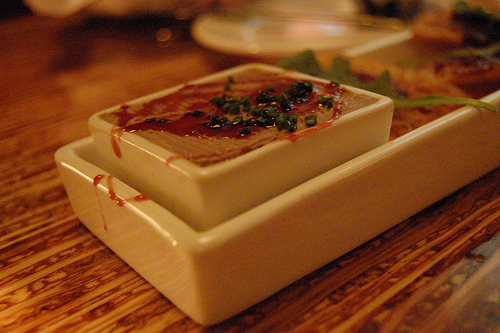
![]() photo credit: stu_spivack
photo credit: stu_spivack
Recession Cuisine: The Sacred Liver
by Stephanie Small, Boda Blog
“That we are in the midst of crisis is now well understood.” - Barack Obama, 1/22/09
Fear is in the air and funds are short. In tough economic times, it’s best to pull inward, hunker down, and get to some serious grounding. And what’s more grounding than a hearty home-cooked meal? Food’s one of the easiest areas in which to scale back spending, with the added benefit that the simplest meals are often the most satiating (maybe that’s why, when you eat at that Noveau Japanese-Cajun-Antarctican fusion joint you always leave hungry…). And if you reach back to traditional societies, you’ll find easy, inexpensive recipes that are packed with nutrition.
Every native culture has sacred foods that are fed to children and pregnant women. This food is chosen for its superior nutritional value - people who are growing, and people who are growing other people, require a powerhouse of vitamins and minerals in order to perpetuate a strong, vibrant, healthy species. Well, guess what. Very often the sacred food is liver. It’s fallen out of fashion, but even as recently as 50 years ago liver was a weekly staple in many homes. It’s sad that we now focus on the animal’s muscle as our protein source - it’s not anywhere near as nutritious as the organs. But it’s certainly good for those of us who still choose to nourish our bodies with this potent substance: a pound of organic livers will often cost you less than $4. Talk about getting a ton of bang for your buck. If we are trying to maximize nutrition and taste while minimizing dollars, look no further.
On Valentine’s Day I prepared pate using elk liver from High Wire Ranch. The animals are fed a diet entirely of grass and hay, with no antibiotics and no hormones. Talk about old-school and the way things should be. For some of Saturday’s diners, including a vegan recently fallen from grace, it was their first experience feasting on this delicious and nutritious organ.
Now, if you are new to liver as well, you are probably recoiling in disgust and imagining a nasty, floppy, sloppy thing. Well, I am happy to say this pate wasn’t one of the more “livery” ones I’ve produced. The seasoning, onion, and olive oil merged to offer a creamy, tender, spicy flavor. The former vegan had an interesting experience watching me cook. Initially repulsed by the blood, which I told her was a cranberry marinade, she then switched gears and decided to sample a bite of liver raw, as she had watched Sundancers do. It had the consistency of a crisp melon.
Liver is nature’s most concentrated source of Vitamin A and contains all the B vitamins in abundance. Many of us tend to be deficient in both. It’s also one of our best sources of folic acid, iron and copper. And on Sunday we experienced another of liver’s legendary benefits: the anti-fatigue factor. We were all shocked by the fact that despite drinking to excess and sleeping 4 hours the night before we were all actually able to function relatively well.
“But doesn’t the liver store the toxins?” you might ask. The liver neutralizes toxins; it does not store them. Toxins are more likely to be lodged in the fatty tissues and nervous system. But the liver DOES store a host of vitamins and minerals, all of which you are able to access by eating it. As always, please select liver with as many adjectives as possible (grass finished, free range, antibiotic free, organic…). It’s best to pass on the conventional. And because liver is so powerful, a 4oz serving once or twice per week is sufficient.
I credit my friend and colleague Lisa Lawson for introducing me to the joys of pate with this simple recipe.
Lisa’s Luscious Liver Pate
1 pound liver, as free range and grass fed as possible, cut into pieces
1/2 onion, chopped
sea salt and pepper
1 bunch parsley
butter, coconut oil, olive oil, or organic lard
seasonings of your choice: try an Italian blend…herbes de Provence…rosemary, garlic, thyme, sage…
1. Sautee onion in oil until translucent (5 min). Remove and place in blender.
2. Add more oil to the pan and add liver.
3. Sprinkle with salt, pepper and seasonings.
4. Cook on both sides. Inside should still be pink (few minutes on both sides).
5. Add liver AND JUICES FROM PAN to blender. If the cooking hasn’t yielded much juice, add a splash of water.
6. Blend.
7. Taste. It shouldn’t taste overly “livery”. If it does, add more seasonings.
8. Eat on its own or with crackers, tortilla, celery, carrot…
9. Prepare for bionic strength!
Stephanie Small is a volunteer chapter leader for the Weston A. Price Foundation in Boulder, Colorado. Her website is www.threesistersnutrition.com. Her blog is Boda blog.
This post is part of the Real Food Wednesdays blog carnival. See more delightful delectables on KellytheKitchenKop.com.





Thanks! I have some liver sitting in my freezer, waiting patiently to be used. I knew my family wouldn’t go for pan-fried liver and onions. This may be just the thing!
.-= Local Nourishment´s last blog ..The end of summer food =-.
Oh, I’m making this tonight! Thanks for sharing the recipe. I’ve made pate before, usually just “winging it.” I never thought to add cooked onions though. Sounds delish.
Cheers,
~KristenM
(AKA FoodRenegade)
Should one rinse the excess blood off first, pat it dry or just start preparing it as is?
The 4 oz is plenty to give an ample supply of B12
.-= Augie´s last blog ..The Spiritual Meaning of Natural Food =-.
Now this is a good way for me to get liver and onions without grossing out. Not the liver, the onions. I have a strange aversion to their texture, but dry them out or toss ’em in a blender and I’m fine. Shame too, they’re also nutritious.
I can attest to vitamin A deficiency being easier than you think. Never rely on beta carotene as your only source or you may find yourself developing mysterious health problems. Mine were reproductive, and disappeared when I started supplementing with fish liver oil.
I rinse off the liver in a colander and dry with paper towels. They will brown easier that way when you cook them.
I love chicken liver pate…would this taste good with beef liver or would the taste be too strong for most palates? (grassfed, of course)
Hi All!
I made this recipe this weekend with chicken livers (from pasture raised chickens, of course). I used Herbs de Provence. One suggestion is, if your onion is not huge, use a whole onion, because mine was small, there was no onion flavor in the finished pate. We still enjoyed it. I froze the rest in small containers for later use, and had a nice lunch with it today, spread on some whole grain toast.
Such an easy recipe! Someone try it with beef liver and let us know how that works!!
I made this liver pate with beef liver today. I cooked up the liver with all the blood…tossed it all in the cast iron skillet and cooked until it was pink inside…it is delicious! This is the first pate I have ever made and I love it!
Wonderful Carol! Thanks for letting us know!
I made this. It came out with a slightly wet texture from the blender and a strong liver taste, even with extra seasonings added. I was about to give up when I decided to dump it into a casserole dish and bake it in the oven. I baked it at 350 degrees for 45 minutes and it came out delicious! It was every bit as good as fine storebought pate. But I admit we sneaked a taste of the whole liver before it was blended and liked that even better. I never realized pan-fried liver was so tasty. It just never occurred to me to make it.
BTW I used grass-fed free-range cow’s liver. That’s probably why it was so strong-tasting. But the oven sure fixed it.
Thanks, Mark for the review of this recipe and your idea of baking it in the oven! I bet a lot of folks will want to try that!!
If anyone else comes up with a variation on this recipe, please share it with us!
I love you!
And by ‘i love you’ I mean thanks for providing a WAPF friendly, simple liver pate recipe thereby sating a craving that has been haunting me for a week now!
How much liquid do you usually end up with after sauteing the liver? Approximately a couple tablespoons? or more like a 1/4 Cup?
I added a bit of water before blending because there didn’t appear to be more than a tablespoon or two of liquid after the liver saute, but it came out awfully wet, so now I’m using the oven trick (thank you mark) .
I wonder if chilling it overnight would firm it up and mellow the liver taste in spite of the moisture content? Good thing I’ve got lots of liver! Thanks again.
Oh boy, Stephanie: Liver! You’re talking my language, girl. Love, love, loooooove! This recipe sounds easy, economical and delish. Can’t wait to try it. Thanks for the fun post.
Where were you able to find organic chicken livers for $4 a pound?? I can’t find any super market or natural food store that sells organic chicken liver, nor could I even find a farm around here that does. I’m in the Denver, CO area. Any tips? Thanks so much!